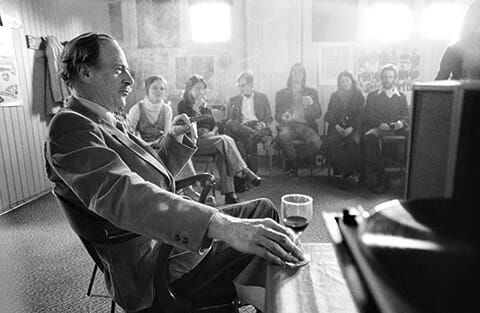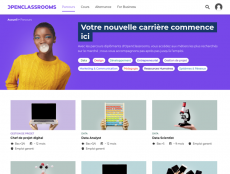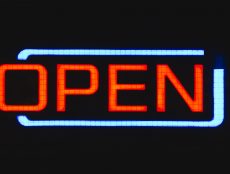
Articles
Editor’s Picks
YouTube Realized McLuhan’s Vision of Education for the TV Generation
By Cait Etherington
April 23, 2018
While most people don’t equate television and learning, in the mid-twentieth century, at least a few educators imagined that the two were an ideal match. Long before video-sharing platforms like YouTube existed, a minority of educators and futurists already foresaw a time when “television learning” would become the norm (as an example, consider how education is depicted in the futuristic 1967 short film, 1999 AD). Perhaps the most well-known champion of television learning, however, was media studies scholar Marshall McLuhan.
Marshall McLuhan’s Vision of Education for the TV Generation
As McLuhan once remarked, “To expect a ‘turned on’ child of the electric age to respond to the old education modes is rather like expecting an eagle to swim. It’s simply not within his environment, and therefore incomprehensible.” His solution was to create education geared to the specific needs and sensory preferences of the television generation. In short, McLuhan believed that new technologies such as television could overcome the tedious nature of the current approach to education. In a 1969 interview with Playboy Magazine, McLuhan, who had six adult children at the time, was asked where he would educate his children if they were still school age. His response was clear: “Certainly not in our current schools, which are intellectual penal institutions. In today’s world, to paraphrase Jefferson, the least education is the best education, since very few young minds can survive the intellectual tortures of our educational system.”
So, what was McLuhan’s solution? According to McLuhan, it was not enough to put televisions in classrooms, which was something some of his peers were calling for at the time. Instead, he said, “We have to ask what TV can do, in the instruction of English or physics or any other subject, that the classroom cannot do as presently constituted.” According to McLuhan, what TV could do was “deeply involve youth in the process of learning, illustrating graphically the complex interplay of people and events, the development of forms, the multileveled interrelationships between and among such arbitrarily segregated subjects as biology, geography, mathematics, anthropology, history, literature and languages.” While this may sound shocking, McLuhan never viewed television as a passive medium for couch potatoes. For him, it was always an active medium.
So, what would McLuhan have thought of YouTube? It seems highly likely that McLuhan would have enthusiastically embraced YouTube as a platform and potential way to transform education. After all, it is not only global in scope, enabling anyone from anywhere in the world with access to a digital device and Internet to share videos on any subject, but also highly interactive. Unlike a textbook, for example, learners can make their own videos and upload and share them with other potential learners and leave feedback on what videos are and are not useful. On this basis, it seems likely that had McLuhan lived to see the launch of YouTube, he would have readily embraced it as a breakthrough educational technology. One might further speculate that McLuhan that would have eventually launched his own YouTube channel.
Early Research on YouTube’s Educational Benefits Was Mixed
To be clear, despite the fact that content-craving K-12 teachers and college professors quickly discovered YouTube (on a bad day, there is nothing like a YouTube video to fill up those unaccounted for minutes in one’s lesson plan), YouTube has also at times proven to be a highly controversial platform among educators.
On the one hand, there were YouTube’s early enthusiasts. Diane Skiba’s 2007 article in Nursing Education exemplifies why many educators were ready and willing to embrace the platform as an educational tool. As Skiba observed over a decade ago, “If you want to engage students of the Net generation, you will want to explore this tool as an adjunct to your classroom or online teaching environments. For example, what will you do if tech-savvy learners submit video projects that they have created instead of traditional papers?” As Skiba emphasized, “This is not a far-fetched idea” since 57% of “online teens” already create content for the Internet. But Skiba wasn’t simply imagining YouTube as a way to enable students to produce video essays. As she also observed, “It is important to think about how tools like YouTube can be used to create a learning community,” since these new tools also allow students to replace passive learning with active participation.
While Skiba was writing to an audience of nurse educators, early on, the benefits of YouTube were being celebrated by educators across fields from physics to history to language studies. Still, not everyone was thrilled about YouTube’s arrival in the classroom. Both in the United States and United Kingdom, YouTube soon became subject to widespread school bans. The rationale was twofold. To begin, schools worried about students accessing inappropriate videos, including those showing nudity and drug use. But by 2007, YouTube had also become widely known as a platform where bullying or more precisely, cyberbullying were rife. On this basis, many school districts blocked YouTube early on. Indeed, it was not until the platform started to introduce separate educational channels in 2012 that many districts relaxed their bans.
YouTube’s Education Channels
Over time, YouTube has evolved from one to hundreds of channels and many of these channels are now education related. Since 2009, there has been YouTube EDU, which centralizes content from over 100 universities and colleges. Channels such as TED-Ed and TED & TEDx are also popular educational sites. And not surprisingly, many leaders in online education from Edutopia to the Khan Academy also have active YouTube channels.
Beyond these general channels, there are hundreds of specialized subject-based channels. Few middle school science teachers, for example, have not resorted to showing at least one Bill Nye the Science Guy video and across levels, instructors rely on sites such as NASA Television. The Library of Congress and The New York Times both offer high-traffic channels geared to humanities educators. And for language teachers, sites such as JenniferESL and BBC Learning English continue to make course prep just a bit less labor-intensive than it was prior to the development of YouTube. Finally, some YouTube education channels, such as MIT OpenCourseWare, have also played a critical part in a larger educational revolution: the development of MOOCs.
The DIY Education Revolution
Perhaps, the greatest contribution YouTube has made to education has happened outside the formal education system. In 1960, if you wanted to learn how to bake a great loaf of bread, you asked your local breadmaker or bought a book. Today, if you want to learn how to bake a great loaf of bread, you likely search for breadmaking videos on a platform like YouTube. Of course, the same holds true for nearly any task from fixing your car to repairing wood floors to knitting a sweater. If you want to learn how to do something, you can likely access the information you need on YouTube easily and free of charge. After all, on YouTube we’re all potential students and instructors. In this sense, YouTube, while by no means a perfect platform, put “you” into the learning process in a way that no earlier educational technology managed to do. In the process, YouTube also achieved something McLuhan called for over three decades earlier: an educational approach capable of deeply involving youth in the process of learning.”








[…] learning resources: https://news.elearninginside.com/forget-cryptokitties-cryptozombies-will-teach-everything-need-know-… https://www.cryptokitties.co/ […]
[…] Forget CryptoKitties, CryptoZombies Will Teach You Everything You Need to Know About Creating Your O… […]